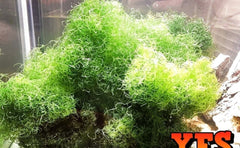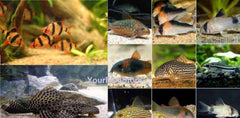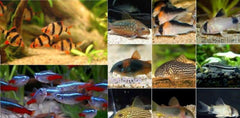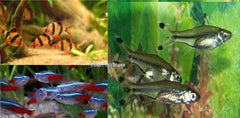X1 Assorted Open Brain Coral - X1 Clove Polyp Green - X1 Assorted Zoa Colony

x1 ASSORTED OPEN BRAIN CORAL - x1 CLOVE POLYP GREEN - x1 ASSORTED ZOA COLONY
*This Package is for:
x1 (One) Assorted Open Brain Coral (Approx: 3" - 5" Each)
x1 ASSORTED ZOA COLONY
x1 CLOVE POLYP GREEN (Med Approx 2-3")
*********************************************************************
x1 ASSORTED OPEN BRAIN CORAL
Care Level: Easy
Temperament: Semi-aggressive
Lighting: Moderate
Waterflow: Medium
Placement: Bottom
The Trachyphyllia Brain Coral is also referred to as a Folded Brain, or Crater Coral and is a large polyp stony (LPS) coral. It may have a folded, or figure-eight shape. Its genus name, Trachyphyllia, comes from the Greek trachys (rough) plus phyllon (leaf) because it resembles a rough leaf lying on the sandy bed. There are two common species of Trachphyllia: T. geoffroyi and T. radiata. The T. radiata, which is usually more convoluted in appearance and has fused walls, was formerly called Wellsophyllia radiata, but the genus Wellsophyllia has now been eliminated.
Natural History
These corals get their common name from the grooves and channels on their surfaces that look like the folds of the human brain. There's more than one kind of "brain coral"—several species from two different families of corals share the name—but all help build coral reefs.
Conservation
Coral reefs around the world are in danger. Silt (fine soil) smothers coral when it washes off the land from farm fields, roads and building sites. More towns and resorts near shore mean more sewage, oil and chemicals in the water.
Cool Facts
While staghorn corals grow rapidly to gain new territory, slow-growing brain corals rely on brawn. They hold their ground by being solid and strong enough to withstand the storms that pound more delicate corals to rubble.
********************************************
x1 ASSORTED ZOA COLONY
Approx: 3" - 5" Each
Care Level: Easy
Temperament: Semi-aggressive
Lighting: Moderate
Waterflow: Medium
Placement: Middle
Water Conditions: 72-78° F, dKH 8-12, pH 8.1-8.4, sg 1.023-1.025
Zoanthids are without a doubt some of the most popular soft corals for beginners and experts alike. Fast growing, super hardy, and available in every color of the rainbow, they are easy to keep and fun to collect. New and unusual color morphs are always being sought, but even the 'common' variants often possess stunning colors.
Other soft polyps, such as Palythoas, Yellow Polyps, Xenia, and Star Polyps are all very similar in requirements to the Zoanthids and are equally hardy. All of these soft polyps are easy to frag. Most grow by encrusting mats or runners over the liverock to which they are attached. This can then be cut inbetween polyps, usually with little harm to parent or frag.
Care Level
Easy.
Aggressiveness
Low to moderate. Generally not prone to stinging their neighbors, although they can grow so quickly that they overtake slower growing corals. Many do put chemicals into the water that can irritate other corals, so diligence in water changes and carbon use may be especially beneficial in a mixed reef that includes them.
Lighting Requirements
Low to moderate, although many will do fine under stronger lighting if properly acclimated first.
Water Flow
Moderate. Excessive flow may prevent them from opening fully.
Tank Placement
Low to mid.
Water Quality
While every effort should always be made to provide good water quality for your tank inhabitants, these corals are generally quite forgiving of temporary lapses and in fact may adsorb some of their nutritional needs directly from the water. This hardiness makes them idea for newer tanks still getting established.
Special Notes
Some of the chemicals produced by Zoanthids are potentially harmful to humans. Use care when handling them, especially if fragging. Wearing gloves is always the best way to be safe when working with reef livestock.
********************************
x1 CLOVE POLYP GREEN (Med Approx 2-3")
Common Names: Star Polyps, Green Star Polyps, sometimes shortened to GSP.
Scientific Name: Briareum violacea or Briareum violaceum. Formally classified as Clavularia viridis.
Description:
Green Star Polyps are small typically light tan to yellowish-green to a bright fluorescent green polyps connected together by a rubbery purple colored mat. Larger colonies can create a dense carpet. The polyps are open during the day and retract at night or when disturbed.
Natural Environment:
?
Hardiness
Green Star Polyps are extremely hardy and a popular soft coral for beginners.
Lighting
Will tolerate fairly low light levels, but will tend to develop brighter or deeper colors under higher intensity lighting.
Water Current:
Prefers moderate water motion though seem to do OK even under strong water currents.
Aggressiveness:
High. While they do not seem to have much of a stinging capability, Green Star Polyps can spread quickly under good conditions and quickly overrun their neighbors. Once established, they can be hard to remove from the rock work and many aquarists have regretted adding them to their tank.
Feeding:
Green Star Polyps are photosynthetic and require no supplemental feeding. It is unknown if they will take any prepared foods.
Supplements & Water Chemistry:
Basically if your water hasn’t killed anything, Green Star Polyps will survive but ideal conditions are the same as for most corals.
Salinity should be maintained between sg 1.024 and 1.026.
Alkalinity should be maintained in the dKH 7-12 range
Calcium should be maintained at 400 ppm or higher.
pH should be maintained between 8.1-8.4
Temperature:
Does well within a range of at least 74º to 84º F
Tank Positioning:
Best positioning for Green Star Polyps is to put them somewhere that you can control their growth if necessary. This may be an isolated rock on the sand or similar type of island from which they cannot escape. They will also cover the back wall of the aquarium which can give a nice look. On smooth surfaces, it is easy to scrap part of the mat off to control the spread.
Propagation:
Easy to propagate. Large mats can sometimes be lifted and cut with scissors into smaller pieces. These small pieces can then be attached to a suitable substrate such as rocks for the coral to attach to. Rubber bands can hold the cuttings in place until they attach to the substrate.
QUESTIONS & ANSWERS
Have a Question?
Be the first to ask a question about this.














